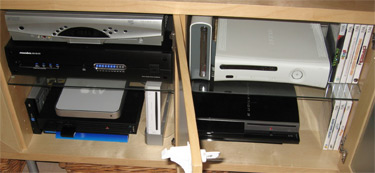Well, I finally did it. I broke down and picked up a Playstation 3.
It’s not the first “next-gen” console to land in my entertainment center. In fact, it’s the third. I was in line at 6 a.m. on Wii-launch-day to get my hands on that great little unit. And not long after, I picked up an XBOX 360 to get a taste of the high definition gaming goodness that my 50-inch plasma TV is capable of showing. I love both of those systems and am honestly a little surprised that I ended up with a Playstation 3….
It seems I may have been wrong about the PS3’s potential.
Well, in part, anyway. I’ve been doing lot of digging over the past few days in order to gain a clearer notion of just what the PS3’s Cell processor brings to the table. A developer does need to write very specialized code that puts the SPEs to work to get real performance out of the Cell – much more specialized than the standard threading techniques that will make the 360 sing, but certain development houses (Incognito and Evolution Studios, for example) seem to have gotten quite comfortable with the architecture and demonstrate impressive results for their effort. I’ve had my 360 for nearly a year now and I can say that the PS3-only titles Warhawk and MotorStorm are more stunningly impressive as far as visuals and performance than anything I’m running on the 360. That said, one can fairly easily determine in side-by-side comparisons that games available for both the 360 and PS3 (which almost always means: developed for 360 and ported to PS3) rather consistently shine brighter on the Microsoft box. All that said, the truth as I see it from where I’m standing is this:
If a game is written to truly take advantage of the unique architecture of the PS3’s Cell processor (heavily utilizing the on-board SPEs) the PS3 can outperform the XBOX 360.
And that is the sort of effort likely to come only from development houses fully dedicated to the PS3 and the PS3 alone. One such group is the aforementioned Evolution Studios who indicate that the impressive MotorStorm “only uses between 15 and 20 percent of available SPU resource” and that they expect to achieve a five-fold increase in co-processor performance in future titles. IBM has posted an informative white paper that analyzes the Cell’s performance.
So there are some impressive titles down the road from developers dedicated to the platform, but my guess is that the typical, multi-platform releases will continue to realize their best potential on the 360. But hey! I’ve got both consoles now, and as such am happily freed of the need to become the sort of this-or-that platform devotee that harks back to to the good old Amiga vs. Atari ST rivalries of my youth. :-)
UPDATE [12.21.2007]: I just ran across an excellent article over at the HCW Tech Blog that takes a very level-headed look at the strengths and weaknesses of Sony’s and Microsoft’s next-gen consoles: Playstation 3 vs. XBOX 360 – One Year Later


